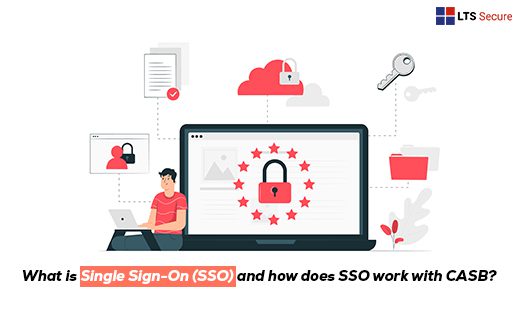How does SSO Work with Implement CASB?
What is Single Sign-on (SSO), and How Does SSO Work with CASB?
Single sign-on (SSO) is a user authentication tool that allows users to securely access multiple applications and services with a single set of credentials. Whether you’re using Slack, Asana, Google Workspace, or Zoom, SSO will pop-up his widget or login page, allowing you to access any built-in app with just your password. Instead of using twelve daily passwords, SSO safely guarantees that only one password is required. A CASB Solution integrates the enforcement of multiple types of security policies.
Single sign-on puts an end to the days of remembering and entering multiple passwords and the frustration of having to reset a forgotten password. It also allows users to access different platforms and apps without having to log in every time. Single sign-on (SSO) is essential to any Identity and Access Management (IAM) or access control service.

What are the Benefits of SSO?
SSO is not only much easier and more convenient for users but is generally considered more secure. This may seem counter-intuitive. How can one login with a password be safer than multiple logins with multiple passwords? Proponents of SSO mention the following reasons:
- Stronger passwords: SSO makes creating, remembering, and using stronger passwords easier because users only need one password. Use stronger passwords with SSO.
- Don’t repeat passwords: When users have to remember passwords for multiple apps and services, they can suffer a condition known as “password fatigue.” This means users reuse passwords between services. Using the same password for multiple services is a significant security risk. All services are only as secure as the one with the weakest password protection. If that service’s password database you can compromise, an attacker can use that password to hack all users, including other services. SSO eliminates this scenario by reducing all logins to her one login.
- Enhanced password policies: SSO makes it easier for IT teams to enforce password security rules by allowing passwords enter in one place. For example, some companies require users to reset their passwords regularly. SSO makes password resets easier to implement. Instead of resetting passwords on different apps and services regularly, the user only has to reset one password. (Although the value of regular password resets you can question it, some IT teams still consider them an essential part of their security strategy.)
- Multi-factor authentication: Multi-factor authentication or MFA refers to using multiple identity factors to authenticate users. For example, in addition to entering a username and password, the user may need to plug in her USB device or enter a code displayed on her smartphone.
- A single point to force password re-entry: Admins can force credential re-entry after some time to ensure the same user is still active on enrolled devices. SSO gives you a central place to do this for all your internal apps instead of enforcing it across multiple different apps, which some apps may not support.
How does SSO Login Work?
Each time a user logs into the SSO service, the service creates an authentication token to indicate that the user has been verified.
An authentication token is a piece of digital information you can store in the user’s browser or on the server of her SSO service, like a temporary identity card issued to the user. All apps accessed by the user check the SSO service.
The Cloud Solution you can pass the user’s authentication token to the app, and the user is authorized. However, if the user is not already logged in, you will prompt them to log in via the SSO service.
The SSO service does not store user IDs, so it does not always remember who a user is. Most SSO services work by comparing user credentials with another identity management service.
Think of SSO as an intermediary verifying that a user’s credentials match her identity in the database without managing it. This is similar to a librarian searching for a book by title on behalf of someone else. Librarians do not store the entire library card catalog, but it is easily accessible.
The user can now access all other applications/websites configured for SSO. When a user wants to access a resource from another application/website. The application/website checks if the user has an active session.
Zero Trust Security is a strategic approach to cybersecurity that protects organizations by eliminating implicit trust and continuously validating all phases of digital interactions.
For more details on SSO, click here: https://en.wikipedia.org/wiki/Single_sign-on
Single sign-on (SSO) is a user authentication tool that allows users to securely access multiple applications and services with a single set of credentials. Whether you use Slack, Asana, Google Workspace, or Zoom, SSO provides a pop-up widget or login page to access any built-in app with just your password. Instead of using 12 passwords daily, SSO safely guarantees that only one password is required.
Single sign-on puts an end to the days of remembering and entering multiple passwords and the frustration of having to reset a forgotten password. It also allows users to access different platforms and apps without having to log in every time.
SSO is based on the concept of Federated Identities. H. Share identity attributes between trusted but autonomous systems. Once the system trusts a user, access is automatically granted to all other users who have established a trust relationship with that user. This forms the basis for his latest SSO solutions enabled by protocols such as OpenID Connect and SAML 2.0.
When a user logs into the service using her SSO login, an authentication token is created and stored either in the browser or on the server of her SSO solution. Any app or website that the user subsequently visits will validate the SSO service and then send the user’s token to verify the identity and grant access.